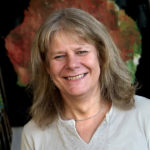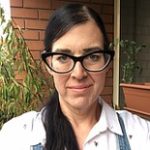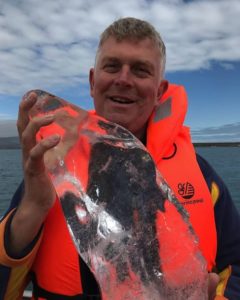Demystifying the IPCC
 by Catriona Nguyen-Robertson MRSV
by Catriona Nguyen-Robertson MRSV
Science Engagement Officer
This article follows our third and final joint presentation with Queers in Science on 6 February, 2020, featuring geoscience educator Dr James Driscoll MRSV from Monash University and climate scientist Dr Chloe Mackallah from CSIRO. The lecture was styled the Penelope Whetton Memorial Lecture in honour of the late Australian climatologist.

The Penelope Whetton Memorial Lecture honoured the scientific memory of Penny, a distinguished Australian climatologist and expert in climate change projections. She was a Lead Author for the Fourth Assessment Report of the UN Intergovernmental Panel on Climate Change (IPCC), which was awarded the Nobel Peace Prize in 2007. It is only fitting that, for this lecture, the presenters demystified the IPCC and debunked a few climate change myths.

Penny was a valued member of the Royal Society of Victoria and a trans woman who underwent gender affirmation. Associate Professor Deanne Fisher (Swinburne University) spoke on behalf of the Queers in Science Organising Committee; she shared that being trans-gender is ‘scary’ and that being an academic as well adds ‘an extra twist’. She struggled to find a senior level person to look up to until she found Penny. Somehow, Penny being herself made it easier for Deanne to be herself.
* * *
The Earth receives its warmth from the Sun. Energy from the Sun reaches the Earth’s atmosphere, it is absorbed by land and oceans. As the land and ocean absorb radiation and heat up, they release heat in the form of infrared (IR) thermal radiation, which passes out of the atmosphere into space. Some of it is trapped by greenhouse gasses. These gasses allow the sun’s strong radiation to penetrate through the atmosphere to Earth, but weaker IR radiation has difficultly in passing back out through the barrier.
The presence of greenhouse gases in the atmosphere is not a bad thing; the average surface temperature of our planet it 15°C but without them it would be -18°C. The problem lies in the rapidly accumulating amount of anthropogenic greenhouse gasses that we are producing.
Humans have emitted two trillion tonnes of carbon dioxide between 1750-2011, and the rate at which we are releasing it is increasing (from 27 billion tonnes in 1970 to 49 billion tonnes in 2011).

Dr Chloe Mackallah (CSIRO, Climate Model Development Division), read directly from the IPCC’s Fifth Assessment Report, which states that ‘[the effects of anthropogenic greenhouse gas emissions] are extremely likely to have been the dominant cause of the observed warming since the mid-20th century.’
‘The IPCC has been saying the same thing since the 1990s, but no one is listening,’ said Chloe. The IPCC warns of risks to food production and security, water availability, species extinction, biodiversity reduction, coastal erosion, floods and droughts, negative impacts on human health, and population displacement.

Dr James Driscoll (Monash University, Faculty of Science) is passionate about science communication and stresses its importance in the face of climate change. As someone who loves volcanoes, he was not convinced when politicians claimed that volcano eruptions release gases that are responsible for the current warming of the planet. In fact, he states, it is the opposite: large volcanic eruptions can result in global cooling events, for example causing a three-year winter after the 1815 eruption of Mount Tambora. While volcanoes release 300-600 million tonnes of carbon dioxide per year, fossil fuel emissions were at 49 billion tonnes as of 2011 – volcanoes are not the ‘smoking gun.’ Myth debunked!
Jim is also concerned about the knack some people have developed of cherry-picking data to support a desired conclusion when it comes discussing climate change. While people may say that they are experiencing the coldest temperatures ever in a city and that therefore global warming isn’t real, they are failing to see the bigger picture. When looking at global weather maps, it may be cold in one particular area, but the world is, on average, warmer.
The IPCC aims to understand the influences driving the Earth’s climate variability and future climate scenarios. It does not conduct its own research or run models; instead, it provides a meta-analysis of the work of thousands of researchers across the globe to provide a scientific basis for governments to develop climate-related policies.

Chloe was frank: ‘climate projection models show scary warming.’ CSIRO has integrated a number of related climate models from universities, CSIRO and the Bureau of Meteorology to produce the Australian Community Climate and Earth System Simulator (ACCESS). The goal of the Paris Agreement is to limit the global temperature increase to 2°C, but even in the lowest emission scenario, if all countries commit to net zero emissions, we will still barely make it according to ACCESS’s simulations. ACCESS predicts an increase in temperature of 6°C by 2094 and that the Arctic may be ice-free in the summer of 2050.
Climate change is something that personally affects us and the weather we experience. Heat waves will become more frequent and last longer. ‘Scientific evidence unequivocally links human-caused climate change to increasing risk of frequent and severe bushfires in the Australian landscape,’ says Jim. ‘It’s only going to get worse without changing our emissions’.
Importantly, we can still make a difference. There are many measures that can be implemented to help address climate change, but no single option by itself is sufficient. Effective implementation depends on policies and cooperation at all scales. Jim and Chloe call on us to spread the word on made-made climate change so that we promote actions that counteract such change.
A livestream video of James’ and Chloe’s presentations is available online from https://www.facebook.com/201662943328320/videos/412741616188167/.








